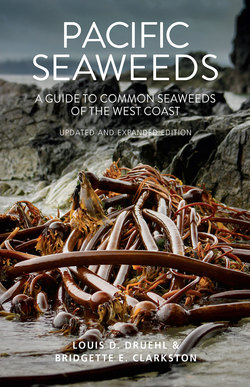Читать книгу Pacific Seaweeds - Louis Druehl - Страница 17
На сайте Литреса книга снята с продажи.
Оглавление17
About Seaweeds
beach with other algae, the blue-green algae and diatoms. Most of these are inconspicuous and microscopic, which is not to say inconsequential. The blue-green algae are photosynthetic bacteria whose presence is indicated by dark, approaching black, variously shaped little slimy colonies. The diatoms, which are normally encountered floating in the sea (phytoplankton), exist as microscopic epiphytes living on seaweeds and as dark brown macroscopic strands attached to rock or seaweeds. These diatom strands may be distinguished from brown seaweed filaments by grinding them between your fingers: the diatom strands will disintegrate, the brown algal filaments will not. Interestingly, brown seaweeds are more closely related to the microscopic phytoplankton diatoms than to other seaweeds (Figure 4).
Figure 4. A family tree of the major groups of life (excluding bacteria and archaea). Coloured ovals highlight relevant lineages within select major groups (major group names in bold); the black circle at centre represents the common ancestor.
Adapted from P. Keeling (2004), American Journal of Botany 91(10), 2004: 1481–1493.
Slime Moulds
Choanoflagellates
Dinoflagellates
Brown Algae
Diatoms
Animals
Fungi
Red Algae
Green Algae
Charophyte Algae
Land Plants
Plantae
Rhizaria
Excavates
Unikonts
Chromalveolates
